| Uncle Al's Pictorial Pearls of Wisdom from the PMG CanAm Regatta a potpourri of educational items suggested by the photos |
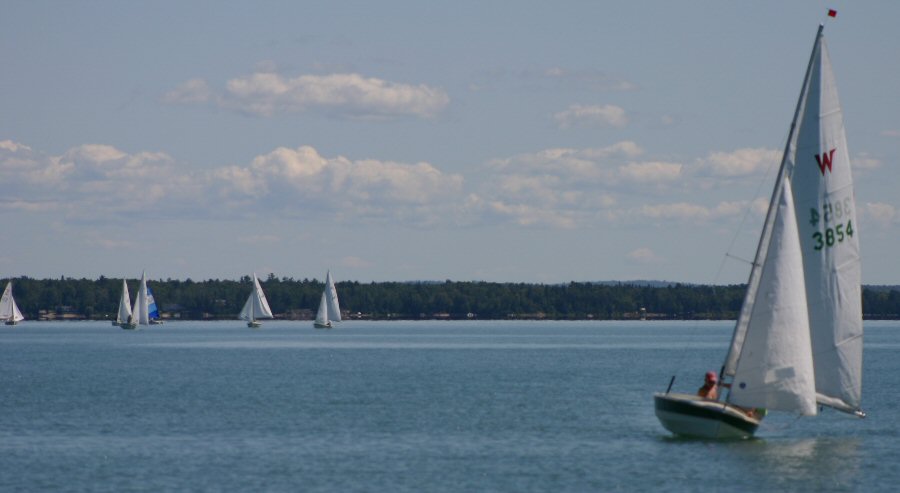 |
|
Very
frustrating sailing, this! Marc and I (3854) ended up doing a
bit of tacking downwind so that we could keep some shape in the sails
when we heeled the boat to leeward (above).
It has been my experience that tacking downwind in heavy dinghies such
as the CL or the Wayfarer rarely pays, expect in really light-air
conditions such as these. Heeling and keeping
the weight well forward further helps by
reducing the boat's wetted area, which in
these drifting conditions, is the major resistance
factor to forward progress - no wave making resistance from poor hull
shape presented to the water when you go this slow!!! One thing
that did work great on this hot morning, was taking off my shirt so
that I could feel the direction of air movement on my perspiring
skin.
... |
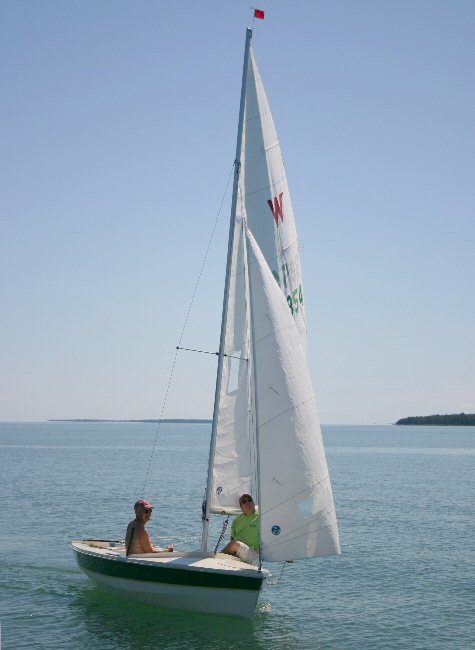 |
|
... |
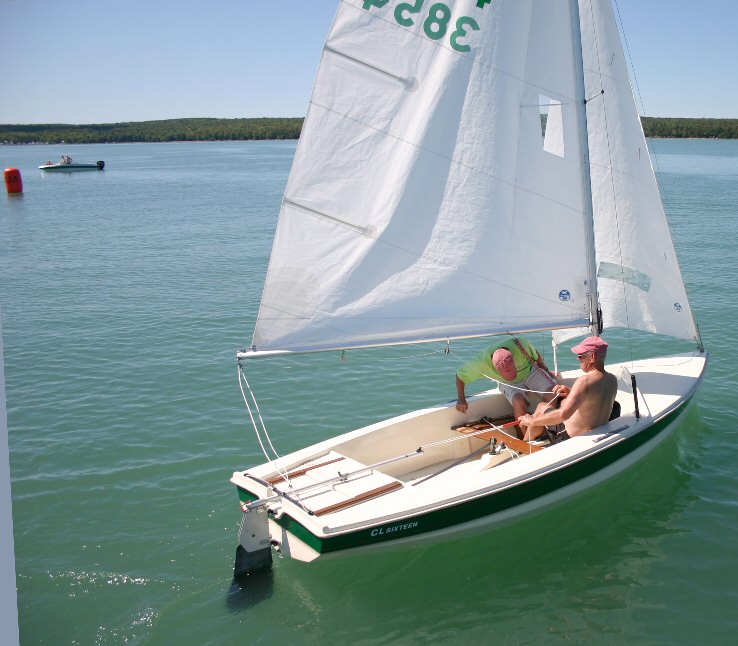 |
|
... not a
comfortable
position for the crew and he is happy to abandon it the moment we get
our finish beep. This shot nicely shows the room gained by aft bench
removal, plus our body positioning well forward for the drifter
conditions. In this nothing breeze it was truly a bonus to have such a
light, easy-running (3/16") mainsheet and its small, light Harken
bullet blocks. Note also how nicely vertical
our rudder blade is: doesn't matter much at this speed but helm feel is
vastly magnified as soon as the boat speeds up a bit if the rudder is
angled even 5 or 10° aft.
... |
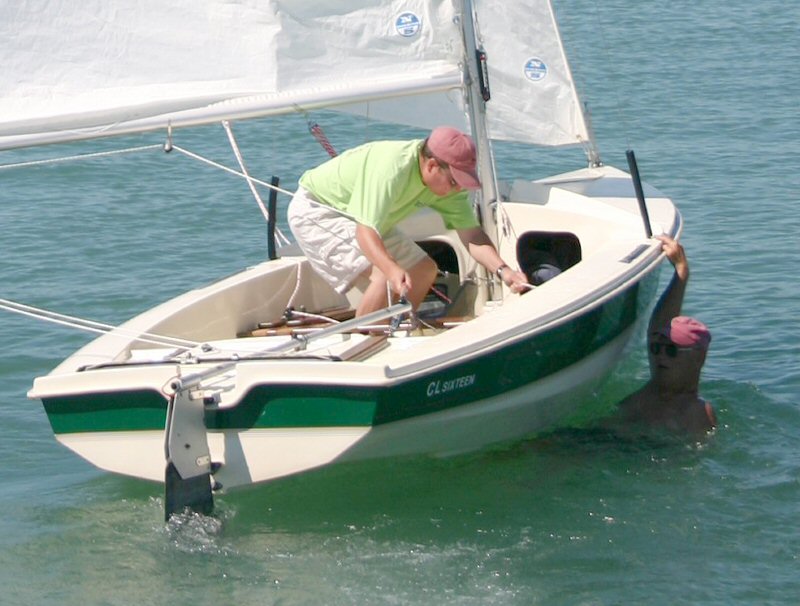 |
|
As soon as
we cleared the
finish line, I flopped overboard for the refreshing dip I had much
anticipated down the whole run. The water was just perfect: crystal
clear and coolly refreshing without being cold. You may well wonder
what the heck this picture is doing here. Well, there is a
purpose: After my swim to
cool off, I found it embarrassingly difficult to climb back into the
boat and I was reminded of ...
... ... |
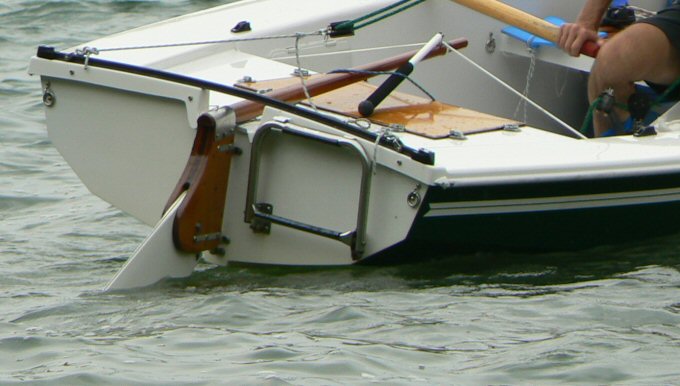 |
|
... this
neat little boarding ladder that I saw
at our 2006 Wayfarer camping/cruising week in the Thousand Islands just
before the CanAm. If re-entry problems are keeping you from swimming
off your CL or Wayfarer, you might wish to invest in something like
this, or ...
... |
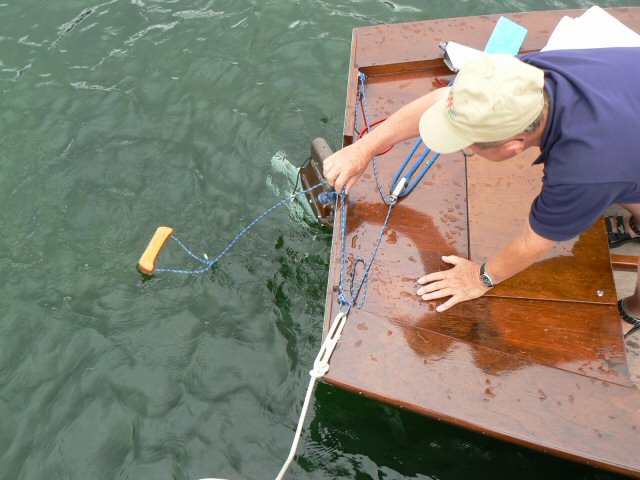 |
| ... this cheaper, easily
stowed, nicely adjustable, alternative solution created by Wisconsin's
Chuck Jordan (above). ... |
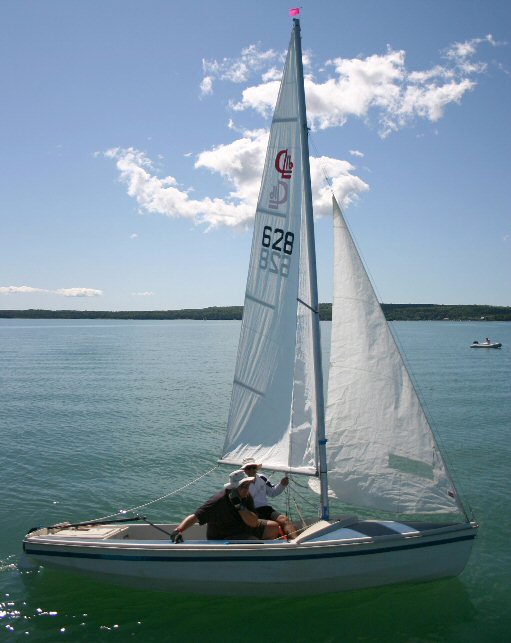 |
|
Mike Codd
and Kirk Iredale and their ragged, clapped out cottage sails gurgle
towards an impressive 2nd.
...Note how their weight is also well forward, and how Kirk is taking weight off the jib leech. |
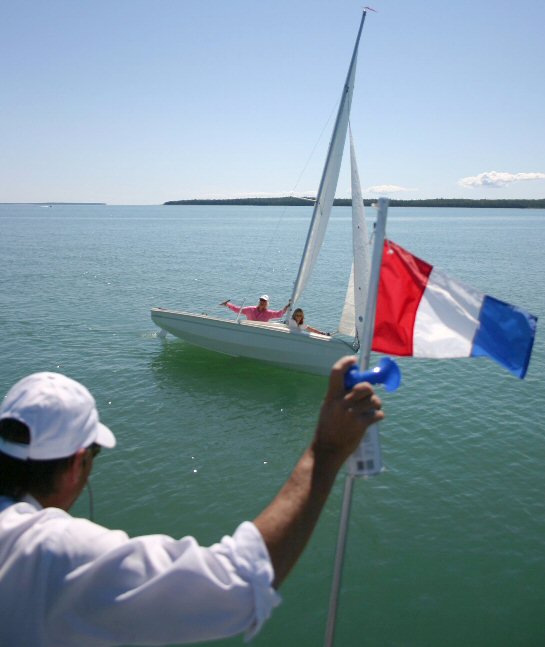 |
| An
exuberant Becky Sylvester is about to cross in 3rd place. Note how she
and Kim Wood are also sitting well forward and have heeled the boat to reduce wetted area. ... |
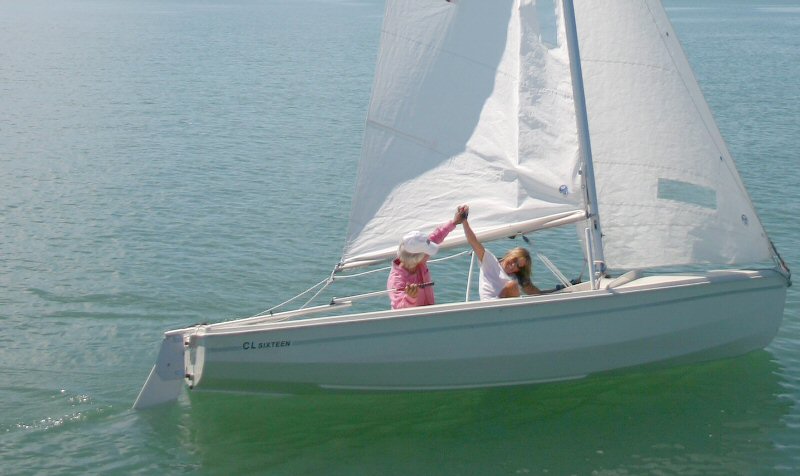 |
|
with the blade down to vertical in any kind of breeze!! ... |
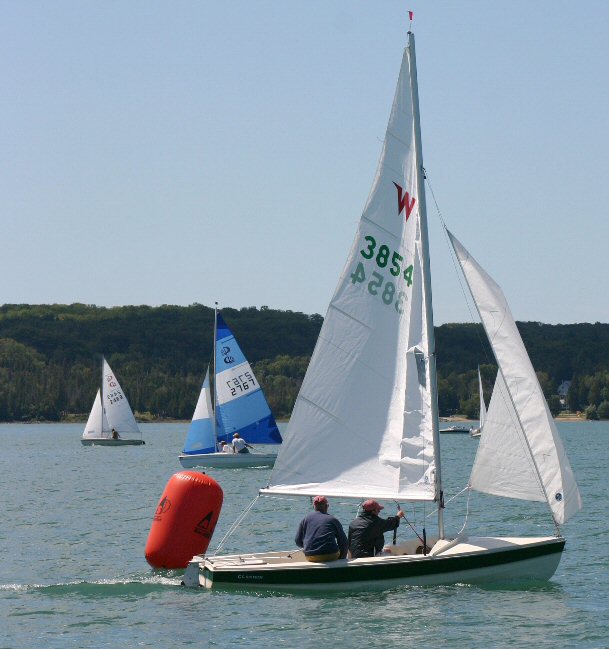 |
|
3854
rounded onto the long run. There had been streaks of better wind
pressure on the beat, so our plan was to take advantage of those by
sailing high in the lulls and down with the puffs. Strategically, we
had decided - before rounding - to defend the left against Jim, so that
if we should meet on a collision course, we would have starboard, and
ultimately, be inside at the mark.
... |
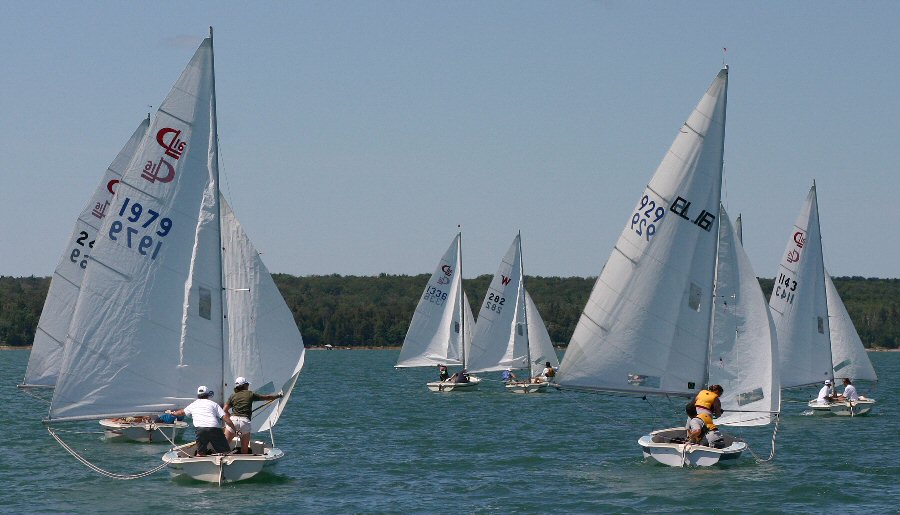 |
| Good
downwind form all around, especially for Colin in 929 whose windward
heel moves his sails' centre of effort more directly above the boat's centre of resistance. ... |
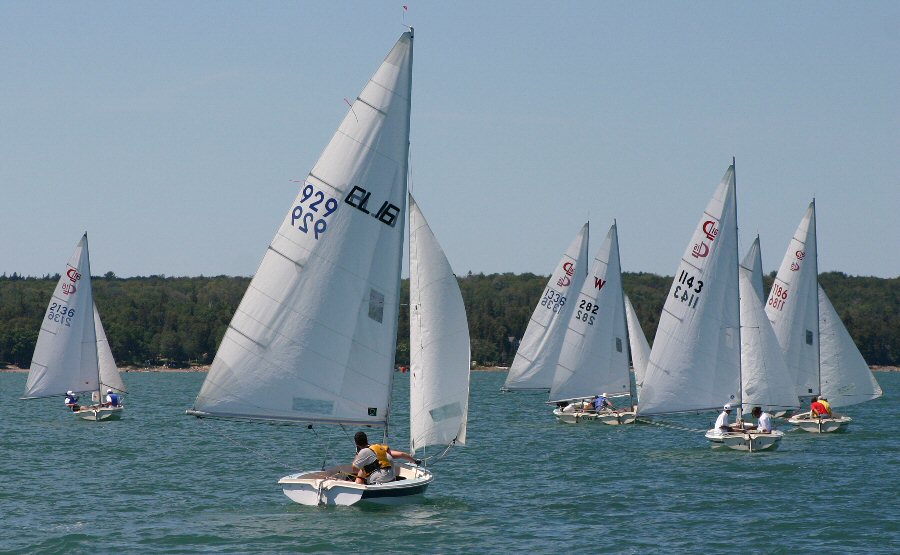 |
|
It
takes mental toughness to overcome the fear that a bunch of boats will
pass you to windward, and to resist the temptation to come up to defend
your lead against that windward bunch. Full marks to John and Laura
Kupers (2136, far left) who are staying out of that mess of boats on
the right, boats that will all tend to slow each other down and perhaps
worse, work each other up to windward and off the rhumb (straight
= shortest) line to the leeward mark. Colin (929) might be wise
to follow John's example: it would indeed be tempting to sail up behind
the group to take their wind as Colin seems intent on doing, but after
that, he'll just be part of the bunch that are slowed down! In Colin's
position, I would take every opportunity (puff) to sail very low (or
even gybe away for a bit?), to try and pass the mess to leeward -
especially in this configuration where going left early lets you meet
them while you're on starboard near the mark, and you will be inside
for buoy room.
... |
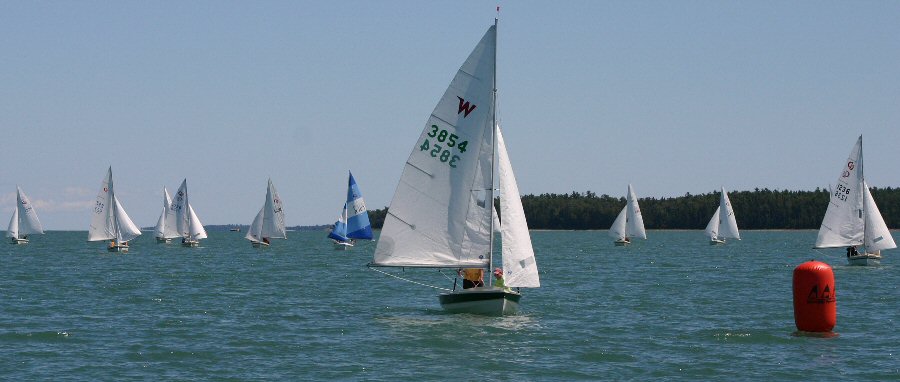 |
|
Marc and
Al close in on the leeward mark
with a considerably bigger edge over Jim (r) than they had at
the start of the leg. Our significant move came about half-way down the
run. Jim had been sitting a nerve-wrackingly close two to three
boatlengths astern and we were constantly having to guard against his
getting on our wind. Finally, I saw an opportunity to make gains as
there seemed to be better breeze just off to our left. Don't be
greedy is a very valid Stuart Walker maxim, but I was thinking
ahead to a long beat, and remembering how Jim and Alice had been just a
touch faster than we had been up the the first beat. What we needed was
a cushion, so it wasn't really being greedy, I remarked to my crew. He
somewhat reluctantly agreed to let me gybe away from Jim. The effect
was electric and by the time Jim had seen the wisdom of our ways, we
had increased our lead to what you can see above.
... |
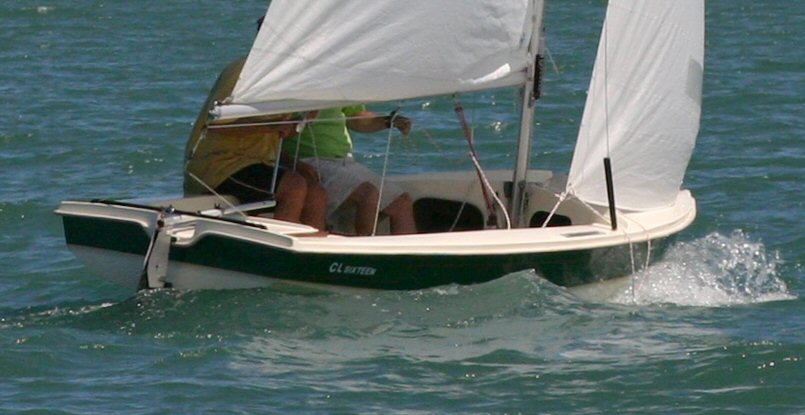 |
|
This
close-up gives a reasonably
good view of our bridle set-up. The fact that the blocks are moved
closer together by the bridle, lets us get a more precise handle on
mainsheet tension. We set the bridle up such that when there's enough
wind to let both of us hike out, we should normally be able to sheet in
block-to-block. Here, the wind is slightly lighter than that, and the
two blocks are about six inches apart.
... |
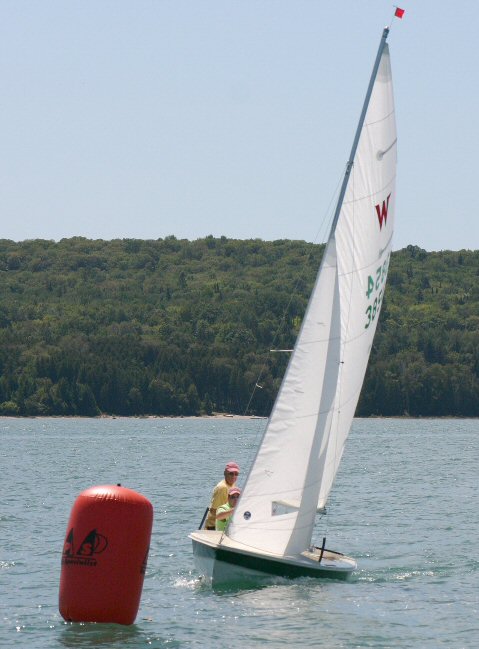 |
|
When
you're hot, you're hot: Having deliberately underlaid the mark in case
a late lift should arrive, we get such a lift just before the mark. We
are heeling the boat because that lets you (briefly!) pinch up better,
a useful
move where you're hoping to get around a mark without throwing in two
more tacks!
... |
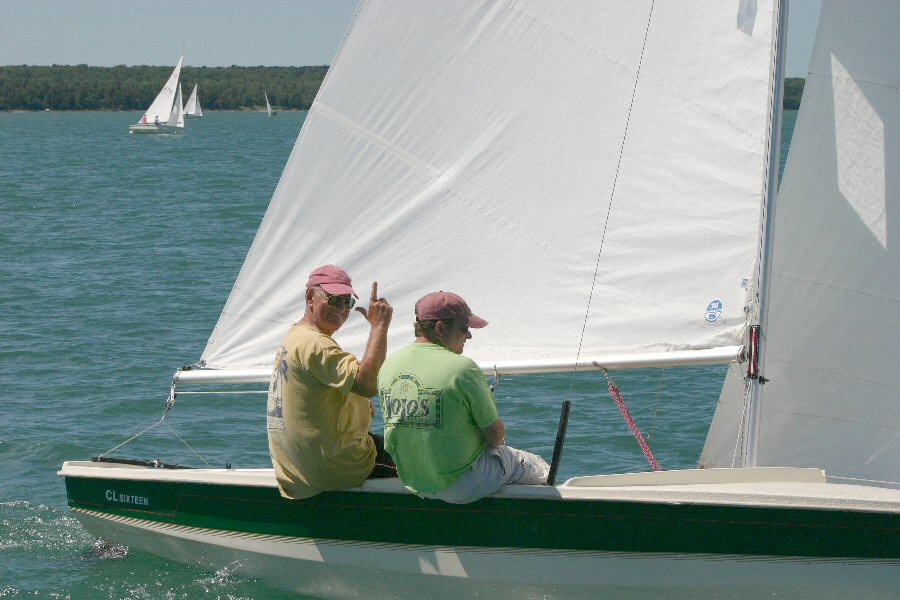 |
|
Al
thanks the committee as he and Marc get the beep. Note how we are now
sheeted block-to-block what with Marc and me both leaning out a bit.
The vang is just tight enough so that it won't fall off the boom - we
don't want vang upwind until we have so much wind that we can no longer
hike the boat as flat as is necessary - at which point, adding vang
tension will let us flatten (and thus, reduce the power of) our
mainsail.
... |
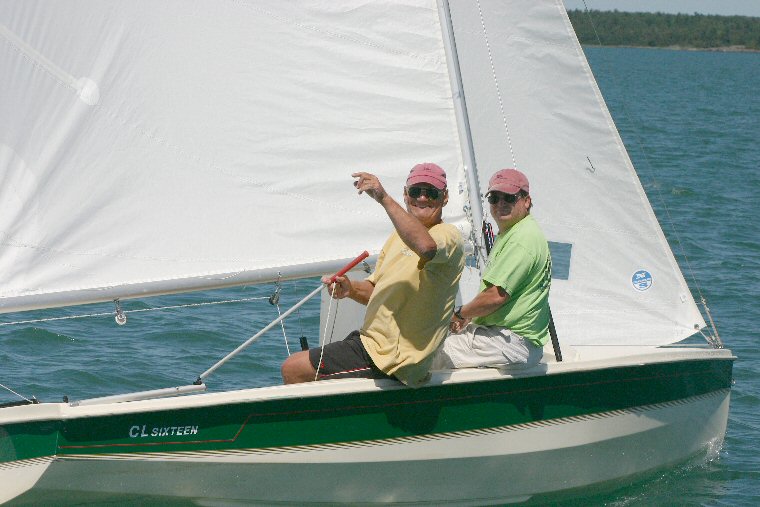 |
|
For
Marc and Al. it's been one of those rare races where everything has
gone right: a perfect start, the early lead, no memorable mistakes and
one or two pretty smart moves. The kind of thing that is best
celebrated with a beer! "As luck would have it," grins Marc, "I just
happen to have packed a few cans ..." and the day reaches total
perfection.
... |
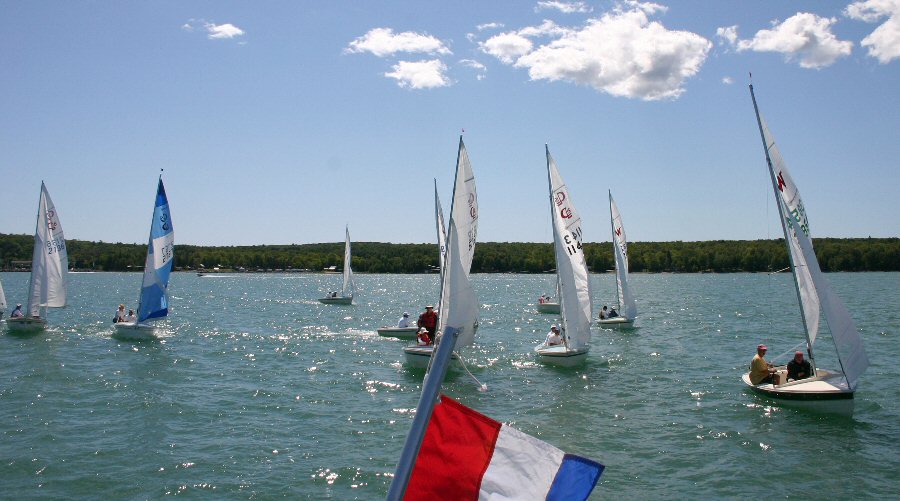 |
|
The RC
boat end (above) was attracting quite a crowd with
perhaps 30 seconds to go. Note that Al (r) has parked in a nice
spot with just a smidgen of forward momentum to maintain steering
control. If someone comes up from leeward, Al will have room to come up
without hitting the RC boat.
... |
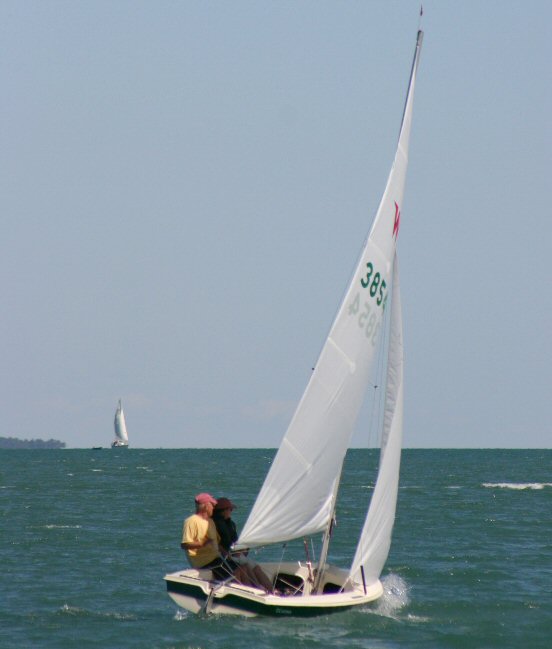 |
| The wind
continued to increase very gradually and Marc and I actually began to use some vang to help us keep the boat flat in some of the puffs. ... |
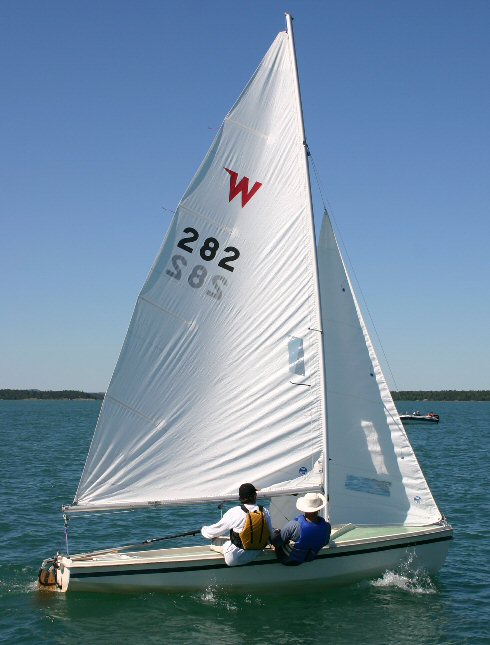 |
| Finishing a
great race in 2nd with a big edge over 3rd, were Andrew Haill and Dave Hansman. Note how their jib halyard, like ours, was not overly tight! ... |
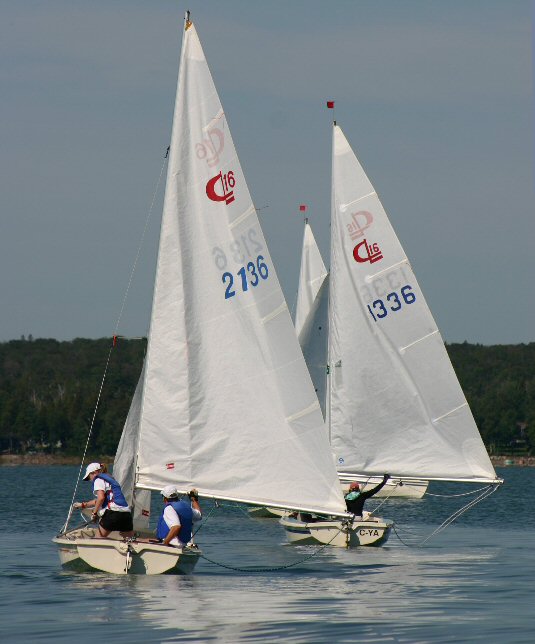 |
|
Like
yesterday morning, the wind veered near this shore and made the
second-leg reach into run. Here, John Kupers (2136) and Kipp Sylvester
(1336) are following Al's example. All three have gybed and are sailing
about
60° high of the rhumb line in the quest for the only thing that
matters:
wind!!! You can tell by Al's and Kipp's masthead fly though, that the
upper parts of their masts and sails have already reached the main wind
once more and that in seconds, they should be able to gybe back and
sail away - always provided that they don't get dumb and sail too high
on the new tack and out of the wind once more!!
... |
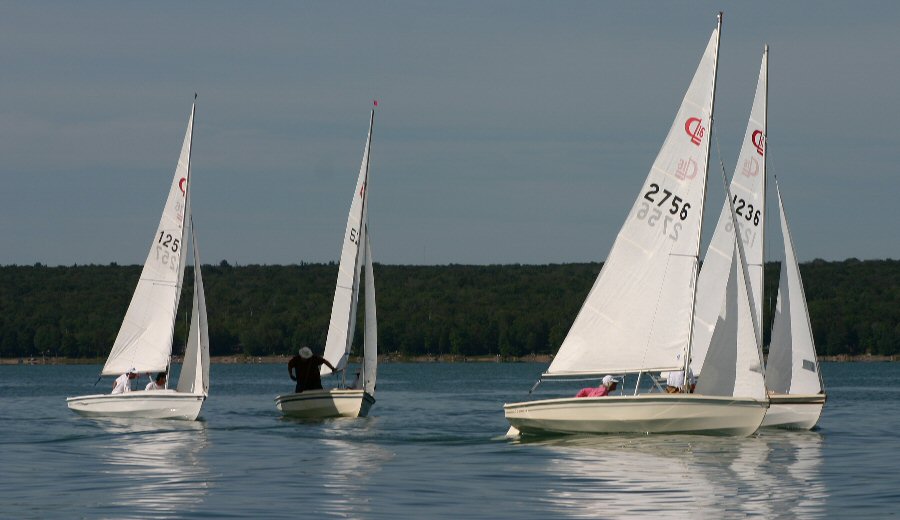 |
|
Very
near the windward mark: Looks like Mike (628) has tacked under Three in
hopes he will survive until Becky (2756) and Jim (1236) round and get
off his wind. By the way, assuming that neither 2756 nor 1236 completed
a tack within two boatlengths of the mark, is Jim (1236) entitled to
room at this windward mark? Yes. Rule 18 does not apply at a windward
between boats on opposite tacks. But that is obviously not the case
here!
... |
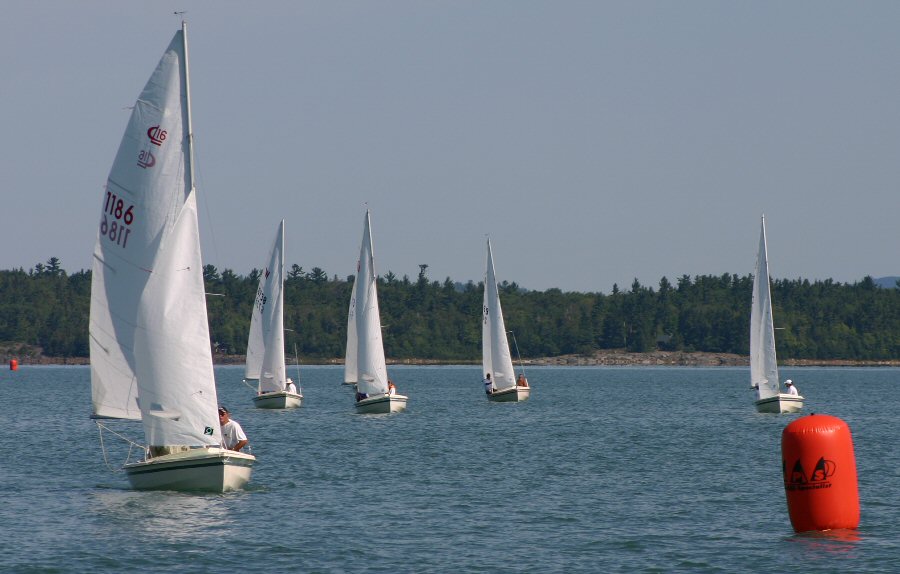 |
|
Charles
and
Bill (1186) have their sails perfectly trimmed (but watch for the
tangled mainsheet!). Behind Charles are:
(l to r) John Hershey, Steve Macklin, Eric
Kirby and Jake Dann who all look overtrimmed to various degrees.
Remember: when in doubt let it out!
... |
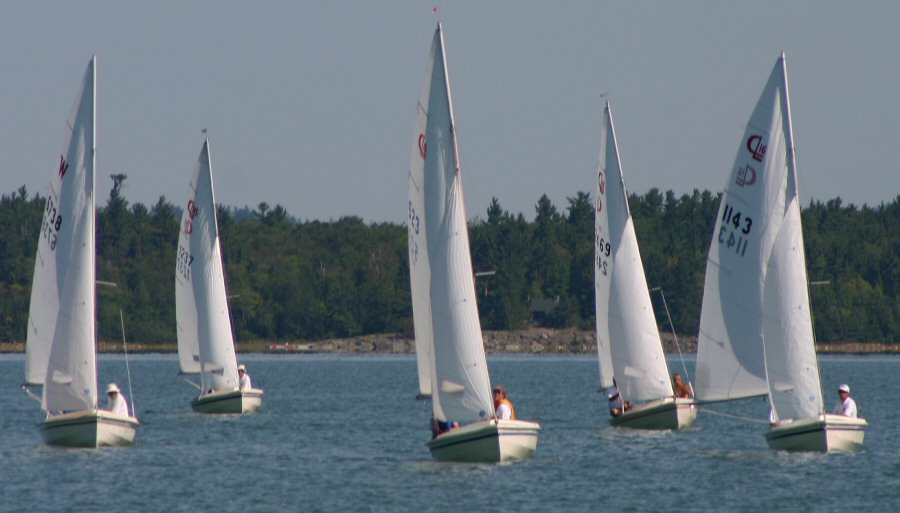 |
|
(l
to r) John Hershey, Bob Tisdall, Steve Macklin, Eric Kirby, Jake
Dann - only Jake has his sails out where they belong here, the others
should notice that Jake's sails are so far out without luffing, and
should at least try to see if their sails, too, can be eased: let them
out til they start to luff and then sheet in a smidgin!!
... |
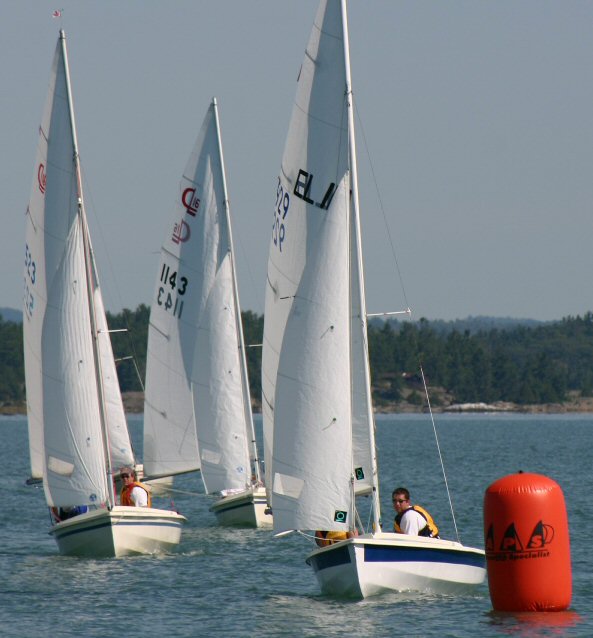 |
|
If Colin
(929) is clear ahead here, he could/should afford to round "wide and
close" which would let him keep his speed better during the rounding
(gradual vs. sharp course change). If, on
the other hand, he had a
boat overlapped to leeward here, however, he would only be entitled to
room
to make a "seamanlike rounding", i.e. close and close, as Colin is
doing here (though he didn't have to!).
... |
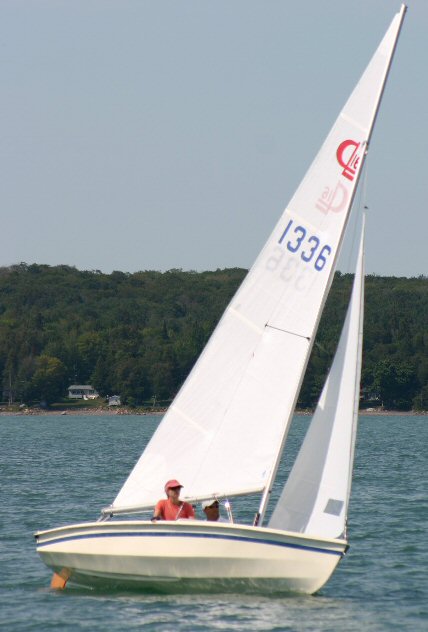 |
|
In
anything but a drifter, heeling
like this looks fast and pretty.
But unless you want to benefit from letting the boat round up to
windward
briefly, fighting the extra helm to keep the boat going straight is
slow. Also, your centreboard and rudder are not working at an efficient
angle!!
... |
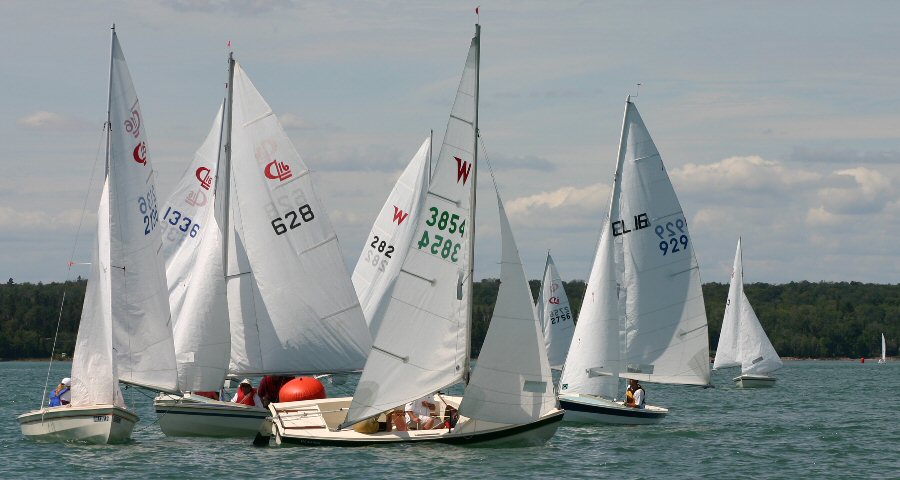 |
| This is one
of the few times it pays to go well high of the rhumb line. For Al this
is the fastest way out of the dead air caused by the boats near the mark. |
| next Pearls
page return to index |